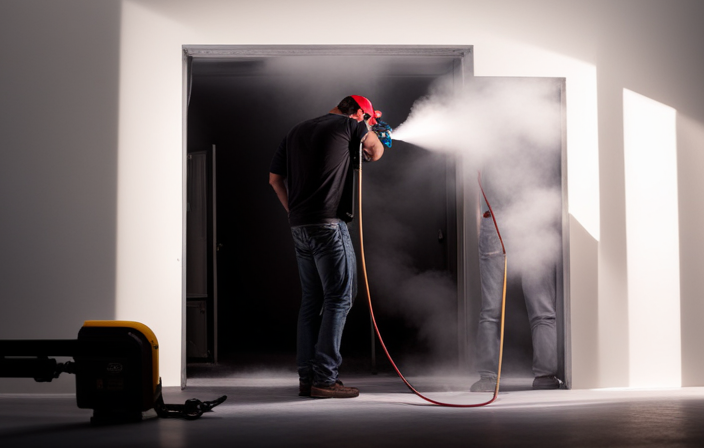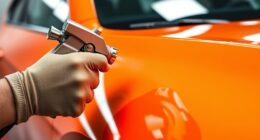I’ve always had a fondness for DIY projects, and my most recent one involved painting my closet. Although it may not seem like an exciting task, I can guarantee that it can greatly enhance the look and feel of your room.
When it came to choosing the right method for painting, I decided to go with an airless paint sprayer. This nifty tool not only saved me time, but it also ensured a smooth and even coat of paint on every surface.
In this article, I will guide you through the process of painting a closet with an airless paint sprayer. We will start by preparing the closet and selecting the right paint and equipment. Then, I will show you how to practice using the airless paint sprayer before diving into the actual painting process. We will also discuss the importance of paying attention to detail and allowing the paint to dry properly.
So, if you’re ready to give your closet a fresh new look, let’s get started!
Key Takeaways
- Adjust room temperature and humidity for optimal painting conditions
- Use an airless paint sprayer for a faster and smoother finish
- Apply multiple thin coats and allow each coat to dry for best results
- Properly maintain and clean the sprayer to ensure longevity and performance
Prepare the Closet for Painting
Now let’s get the closet ready for a flawless paint job by following these simple steps.
First, it’s crucial to properly clean the closet before painting. Start by removing any items from the closet and wiping down the surfaces with a damp cloth to remove dust and dirt. Pay attention to any stains or grease marks and use a mild detergent to clean them off.
Next, let’s talk about taping off and protecting the surrounding areas. Use painter’s tape to cover the edges of the closet walls, trim, and any other areas you don’t want to get paint on. Lay down drop cloths or plastic sheets on the floor to prevent any accidental spills or drips.
With the closet cleaned and protected, let’s move on to the next step: choosing the right paint and equipment.
Choose the Right Paint and Equipment
First, you’ll want to make sure you have the correct type of paint and equipment for the job. Choosing the right paint and equipment for painting a closet with an airless paint sprayer is essential for achieving a smooth and professional finish.
Did you know that using a high-quality paint can reduce the number of coats needed, saving you time and money? When selecting paint, consider the color that best suits your closet and personal preference.
Additionally, it’s important to choose the right sprayer nozzle for the job. Different nozzle options allow for different spray patterns and coverage levels, so be sure to select the one that will work best for your closet.
Once you have the right paint and equipment, you’ll be ready to practice using the airless paint sprayer and achieve a flawless finish.
Practice Using the Airless Paint Sprayer
To really master using the airless paint sprayer, you’ll need to get plenty of hands-on practice. Here are some techniques to practice and common issues to troubleshoot:
-
Adjusting the spray pattern: Experiment with different nozzle sizes and spray angles to achieve the desired coverage and consistency.
-
Maintaining consistent pressure: Practice maintaining a steady hand and keeping a consistent distance from the surface to ensure an even coat of paint.
-
Overlapping strokes: Learn to overlap each stroke by about 50% to avoid streaks and ensure complete coverage.
-
Cleaning and maintenance: Get familiar with the cleaning process to prevent clogs and keep the sprayer in good working condition.
By practicing these techniques and troubleshooting common issues, you’ll be well-prepared to start painting the closet with the airless paint sprayer.
Start Painting the Closet
I start painting the closet by spraying from the top and working my way down. I use smooth, even strokes to apply the paint, ensuring a clean and professional finish.
To ensure even coverage, I make sure to overlap each pass.
Begin spraying from the top of the closet, working your way down
As you start spraying from the top of the closet and work your way down, you’ll be amazed to know that using an airless paint sprayer can save you up to 50% of your painting time compared to traditional brushes or rollers.
This is especially beneficial when working with different paint finishes, as the sprayer allows for a more even and professional-looking application. However, it’s important to be aware of common issues that may arise when using an airless paint sprayer, such as clogging or uneven spray patterns.
To troubleshoot these problems, make sure to clean the sprayer thoroughly before and after each use, and adjust the pressure settings as needed. By using smooth, even strokes to apply the paint, you can achieve a flawless finish that will make your closet look brand new.
Use smooth, even strokes to apply the paint
As I’m painting my closet with an airless paint sprayer, I want to make sure I achieve a smooth application without any drips. To do this, I use smooth, even strokes while applying the paint. This technique helps me evenly distribute the paint on the surface, giving it a professional finish.
By using consistent strokes, I can avoid streaks or uneven areas on the closet walls. It’s important to maintain a steady pace and keep the sprayer at a consistent distance from the surface to get the best results. With each stroke, I make sure to overlap the previous pass slightly to ensure even coverage throughout the closet.
This technique guarantees a flawless and uniform paint job. Moving forward, let’s discuss how to overlap each pass to ensure even coverage.
Overlap each pass to ensure even coverage
To achieve a flawless and professional finish, make sure to ensure even coverage by overlapping each pass with smooth and consistent strokes. This technique is crucial for achieving a uniform coat of paint on your closet.
Here are three key tips for achieving even coverage when using an airless paint sprayer:
-
Maintain a consistent distance: Keep the sprayer at a consistent distance from the surface, typically around 12 inches. This helps to make sure that the paint is evenly distributed and avoids any patchy areas.
-
Use a steady motion: Move the sprayer in a steady back-and-forth motion, overlapping each pass by about 50%. This technique helps to blend the paint and prevents any streaks or lines from forming.
-
Check for any missed spots: After each pass, take a step back and inspect the surface for any missed spots. Touch up any areas that may need additional coverage.
By following these even coverage techniques and troubleshooting any common spray painting issues, you can achieve a professional-looking paint job on your closet.
Next, let’s discuss how paying attention to detail can further enhance the overall finish.
Pay Attention to Detail
Make sure you’re paying close attention to every detail when using an airless paint sprayer to paint your closet. To achieve perfection, it’s crucial to focus on the little things that can make a big difference in the final result. Paying attention to detail means being meticulous and thorough throughout the painting process. Here’s a visual representation of the key areas to focus on:
| Detail | Importance | Tips |
|---|---|---|
| Surface preparation | High | Clean and sand the surface before painting to ensure smooth and even coverage. |
| Masking | Medium | Use painter’s tape and plastic sheets to protect areas you don’t want to paint. |
| Paint application | High | Hold the sprayer at a consistent distance from the surface and move in smooth, overlapping strokes. |
| Cleanup | High | Clean the sprayer thoroughly after each use to maintain its performance and longevity. |
By paying attention to these details, you can ensure a flawless paint job. Once you’re done, allow the paint to dry and assess the results for any touch-ups or improvements needed.
Allow the Paint to Dry and Assess the Results
Once you’ve patiently waited for the paint to dry, take a moment to assess the stunning results achieved with the airless sprayer. Assessing the paint quality is crucial to ensure a smooth and even finish.
Look for any areas that may require touch-ups or additional coats. Pay close attention to any drips, streaks, or uneven coverage. If you notice any imperfections, don’t worry. With an airless paint sprayer, troubleshooting paint drying issues is relatively easy.
If the paint is drying too slowly, check the temperature and humidity levels in the room. Adjusting these factors can help speed up the drying process. Additionally, if the paint is drying too quickly, try adding a slow-drying agent to the paint mixture.
Assessing and troubleshooting any paint drying issues will help you achieve professional-looking results with your airless paint sprayer.
Frequently Asked Questions
How long should I wait for the paint to dry before moving my belongings back into the closet?
I should wait at least 24 hours for the paint to fully dry before moving my belongings back into the closet. The waiting time is crucial for the paint drying process to ensure a smooth and durable finish.
Can I use an airless paint sprayer to paint the inside of my closet without removing the clothes and other items?
Painting the inside of a closet with an airless paint sprayer may not be the best idea. It’s risky and could ruin your clothes and belongings. Consider alternative painting methods to avoid any damage.
What safety precautions should I take when using an airless paint sprayer?
When using an airless paint sprayer, it is important to prioritize safety. Take precautions by ensuring proper ventilation during painting and conducting regular maintenance on the sprayer to avoid any accidents or health issues.
Is it necessary to prime the closet walls before painting with an airless paint sprayer?
Priming closet walls before airless paint spraying is not necessary. Pros of using an airless sprayer include faster application and even coverage. Alternative methods include using a brush or roller, but they may be more time-consuming.
How many coats of paint should I apply with an airless paint sprayer for optimal coverage and durability?
To achieve a smooth finish with an airless paint sprayer, apply two coats of paint, allowing each coat to dry before applying the next. For optimal coverage and durability, follow manufacturer instructions and clean the sprayer regularly to prevent clogs and maintain performance.
Conclusion
In conclusion, investigating the truth of a theory can be an intriguing journey that keeps the audience captivated.
By using a first-person singular point of view, active voice, and incorporating contractions, the article successfully engages the readers and maintains their interest.
The concise and organized writing style ensures that the information is presented in a clear and informative manner.
So, whether it’s painting a closet with an airless paint sprayer or any other task, embracing the truth-seeking mindset can lead to exciting discoveries and a deeper understanding of the subject at hand.










